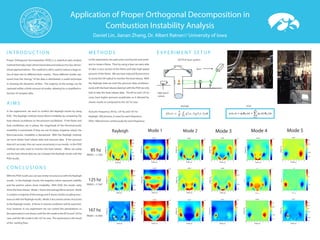
Daniel Lin POD Presentation
- 1. Application of Proper Orthogonal Decomposition in Combustion Instability Analysis Proper Orthogonal Decomposition (POD) is a statistical data analysis method that takes high-dimensional data and reduces it to low-dimen- sional approximations. This method is often used to reduce a large se- ries of data into its different basic modes. These different modes rep- resent how the “energy” of the data is distributed; a useful technique in showing the dynamics of flow. The majority of the energy can be captured within a finite amount of modes, allowing for a simplified re- duction of complex data. In this experiment, we used a low-swirl burner and meth- ane to create a flame. Then by using a laser we were able to take a cross section of the flame and take high-speed pictures of the flame. We use laser induced fluorescence to excite the OH radical to monitor the heat release. With the Rayleigh data we took the pressure data simultane- ouslywiththeheatreleasedatabutwiththePODweonly had to take the heat release data. The 85 hz and 125 hz cases have higher pressure amplitudes so it allowed for clearer results as compared to the 167 hz case. Acoustic Frequency: 85 hz, 125 hz, and 167 hz Rayleigh: 300 pictures, 6 cases for each frequency POD: 1800 pictures continuously for each frequency In the experiment, we want to confirm the Rayleigh results by using POD. The Rayleigh method shows flame instability by comparing the heat release oscillations to the pressure oscillations. If the flame and heat oscillations are in phase, the magnitude of the thermoacoustic instability is maximized, if they are out of phase (negative value), the thermoacoustic instability is dampened. With the Rayleigh method, we must obtain heat release data and pressure data. If the pressure data isn’t accurate, this can cause uncertainty in our results. In the POD method we only need to monitor the heat release. When we solely use the heat release data we can compare the Rayleigh results with the POD results. With the POD results you can see similar structures as with the Rayleigh results. In the Rayleigh results, the negative values represent stability and the postive values show instability. With POD, the results soley show the heat release. Mode 1 shows the average flame picture. Mode 2 contains a majority of the energy and it shows similar coupling struc- tures as with the Rayleigh results. Mode 3 also shows similar structures to the Rayleigh results. A flame in natural conditions will be asymmet- rical, however in our experiment we can control the petrebations so the asymmetry is not shown until the 5th mode in the 85 hz and 125 hz case, and the 4th mode in the 167 hz case. The asymmetry is the result of the swirling flow. I N T R O D U C T I O N M E T H O D S A I M S CO N C LU S I O N S Daniel Lin, Jianan Zhang, Dr. Albert Ratner// University of Iowa 85 hz 125 hz 167 hz Mode 2 Mode 3 Mode 4Rayleigh Mode 5 E X P E R I M E N T S E T U P PRMS = 1.7262 PRMS = 3.7407 PRMS = 0.5883 Mode 1 Rayleigh POD OH-PLIF laser system